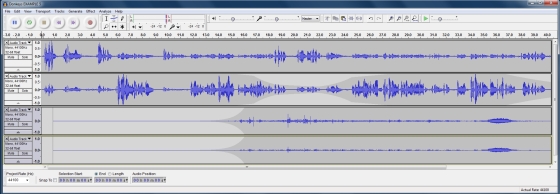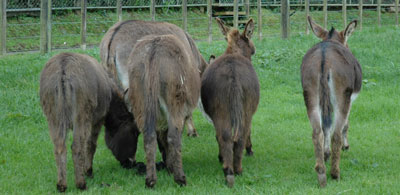 Prime cuts
Prime cuts
So, your podcast interview using two handheld microphones is in the can and ready to be edited in post-production.
In this article we’ll load your interview into editing software, chop it up and craft it a little.
Let’s assume for the sake of this exercise that you will be podcasting a mono audio file. Mono is often preferred as a stereo file is larger and soaks up more bandwidth.
We’ll import our short example from the previous post into the audio editing software, Audacity, which is free to download software, easy to use and popular amongst podcasters.
Here’s what our Donkey interview example will look like in Audacity. We can see the audio within the two channels (left and right) visually, my voice is on the top track and the interviewee’s voice is on track 2.
Now I’m able to manipulate the sound from either microphone by panning them left or right, increasing the volume of each individually, or applying other processing. If I had recorded both mics as a mono file I would not have the luxury of working with the mics individually.
So, our Donkey interview…
To create a mono podcast recording I’ll pan both left and right tracks to the centre. Take a listen.
[Audio=https://intheirtracks.wordpress.com/wp-content/uploads/2010/07/example-4-podcasting-twin-microphone-field-recording-techniques.mp3]
Now, by altering the balance of the mix between the tracks, changing the volume of one or the other, you have some control over how close or distant you would like the person speaking to appear. As mentioned in our previous post which covered two mic interviews, off-mic voice bleeds into your microphone which is further from the sound source.
Lets create an illusion of movement for example, as if our interviewee travels off-mic. By reducing the level of the woman’s mic (track 2) while she is talking and lifting the off-mic interviewer’s level.
(If you don’t want to listen to the whole example just click on the audio player bar in from the start a little.)
[Audio=https://intheirtracks.wordpress.com/wp-content/uploads/2010/07/example-5-podcasting-twin-microphone-field-recording-techniques2.mp3]
As you can hear the interviewee’s voice moves off-mic and returns.
This technique can be used to create interest during extended interview segments augmented with other audio, for example clothing rustle or gravel crunching underfoot to give the illusion of movement. Our Donkey example again.
[Audio=https://intheirtracks.wordpress.com/wp-content/uploads/2010/07/example-6-podcasting-twin-microphone-field-recording-techniques.mp3]
Layering and crafting in this way brings life to an interview which may need spicing up. Obviously the more interesting sound you have available the greater your choices in post-production.
Podcast effects audio is easy to gather
It’s good to get into the habit of recording footsteps, traffic, gates opening, office noise and other appropriate audio when ever possible while you are on location. In this case I lowered my mics, excused myself for a minute of two and wandered across the field.
[Audio=https://intheirtracks.wordpress.com/wp-content/uploads/2010/07/example-7-podcasting-twin-microphone-field-recording-techniques1.mp3]
Fortunately I was rewarded by a gloriously clean donkey bray at the end of this example which I was able to place strategically when the interview needed a lift.
Lets throw a bit of gathered audio behind our Donkey interview example.
[Audio=https://intheirtracks.wordpress.com/wp-content/uploads/2010/07/example-8-podcasting-twin-microphone-field-recording-techniques.mp3]
Let’s look at how you can enhance your podcast with field recorded sound.



